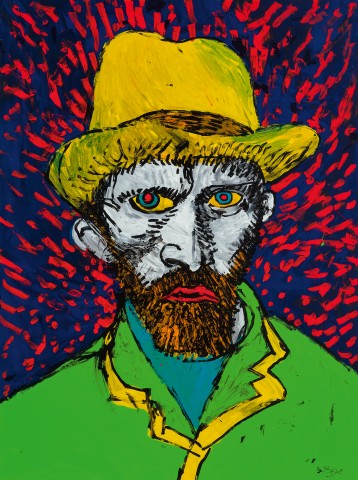VINCENT, 1970
MARTIN SHARP
synthetic polymer paint on plastic
163.0 x 121.0 cm
signed and dated lower right: Sharp 70
Tolarno Galleries, Melbourne, acquired directly from the artist
The National Australia Bank Art Collection, acquired from the above in May 1980 (label attached verso)
Survey 14: Martin Sharp, National Gallery of Victoria, Melbourne, 15 May - 4 July 1981
The Seventies: Australian Paintings and Tapestries from the Collection of National Australia Bank, National Gallery of Victoria, Melbourne, 15 October – 28 November 1982
The Seventies Exhibition: Selected Paintings from the National Australia Bank Collection, MacLaurin Hall, The University of Sydney, Sydney, 6 September - 1 October 1989, cat. 28 (as 'Vincent (from his Self Portrait)')
re: Creation/Re-creation: the art of copying, 19th & 20th centuries, Monash University Gallery, Melbourne, 17 October - 25 November 1989
The Seventies: Contemporary Australian Paintings from the National Australia Bank Collection, organised by Regional Galleries Association of New South Wales, New South Wales, cat. 24; and touring, Tamworth City Art Gallery, New South Wales, 24 May – 24 June 1990; Dubbo Regional Art Gallery, New South Wales, 11 July – 6 August 1990; Wagga Wagga City Art Gallery, New South Wales, 17 August – 10 September 1990; Moree Plains Regional Gallery, New South Wales, 3 October – 31 October 1990
Lindsay, R., The Seventies: Australian Paintings and Tapestries from the Collection of National Australia Bank, The National Bank of Australasia, Melbourne, 1982, pl. 82, p. 95 (illus.)
Millar, R., 'A Confident 10 Years', The Herald, Melbourne, 21 October 1982, p. 37
'Art on Show', Central Western Daily, New South Wales, 18 December 1987, p. 7 (illus.)
Fenner, F., 'The Good Life: Paintings lost in the 70s', Tamworth Daily Leader, New South Wales, 1 June 1990
Martin Sharp was perhaps the closest Australia had to a true pop artist. His radar was finely tuned to the sites and themes of the times, and his printmaking of the 1960s capitalised on the notion of an art form that is affordable to all. Album covers and posters for the likes of Jimi Hendrix, Bob Dylan and Cream captured this spirit and brought him fame and notoriety. His use of metallic inks was a genius stroke when it came to reflecting the LSD-soaked guitar licks and optical spasms of the psychedelic era.
When Justin O'Brien, Sharp’s art master at high school gave him an art award, the prize was a book on Vincent Van Gogh, and thus began Sharp’s lifelong obsession with the artist. Vincent, 1970, is painted in the manner of the large format, frontal portraits favoured by despots and dictators as propaganda. Generally, these are hoisted high on buildings or carried through streets to enforce the notion of leaders to be revered or feared. Yet Sharp’s portrait here represents the antithesis of those large political portraits. By enlarging Van Gogh’s Self Portrait with a Grey Felt Hat, 1887 in this manner, it is as if Sharp is saying: follow this man… make art not war, peace and love through creativity… look not to the political class, but to the artists for they are the light and the way. Painted with an inspired urgency using bright contrasting colours and alluding to Van Gogh’s dot-dash style, the painting exudes an electric intensity – it demands to be looked at.
In May 1888, Vincent Van Gogh rented a house at Place Lamartine in Arles, which he described as yellow with green shutters. He called it ‘The Yellow House’ and dreamt of it being a place where he and other artists could live and paint together. In the early 1970s in the spirit of Vincent’s Yellow House ideal, Sharp established The Yellow House Artists Collective in the former Clune Gallery on Macleay Street, Potts Point. Named after Van Gogh’s dream of an artistic retreat, artists such as Brett Whiteley, George Gittoes, Bruce Gould, Philip Noyce amongst others collaborated and presented experimental works in every genre from painting and sculpture to film and happenings. In a way, The Yellow House Artists Collective was in itself an artwork; it was a functioning sculpture, an event, a happening and a heaving series of murals all rolled into one. It could be considered as Sharp’s magnum opus and a befitting homage to his artistic hero. Vincent, 1970, represents a rare work by one of Australia’s best-known exponents of pop art, and provides a window into the world of Martin Sharp and his echoing of Vincent van Gogh’s unwavering belief that we can change the world for the better through art.
HENRY MULHOLLAND
